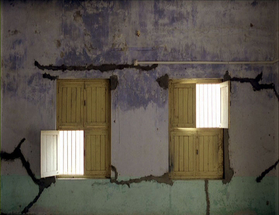Surely everyone who frequents galleries has had this experience: You're wandering round an exhibition that you don't really care for, your scepticism slowly rising. You're not sure if you're missing something or if there's nothing to miss, but every time you're confronted with another indifferent picture with an obscure title you care a little less.

Then you come across something that stops you in your tracks, something that announces its greatness and makes you take your time to consider it. Zarina Bhimji's recent exhibition at the Whitechapel Gallery had this exact effect on me. As you enter you are presented with a series of stills from her latest film. Anyone who has had the misfortune of sitting through my holiday snaps knows my predilection for shots of urban decay ("When are we getting to the Pyramids?" "After the two rolls of film I took at the cement factory.") but when coupled with portentous titles of little discernible relevance my guard was up.
Upstairs, the samples of earlier work manage to achieve the unhappy balance of seeming both facile and obscure, with a tedious insistence on poking sexuality into every orifice, even those where it doesn't belong. Does a photograph of some spray painted pubes really complete an exhibit of photographs of gardens owned by slave merchants, and mirrors engraved with old press cuttings of slave auctions?
Upstairs, the samples of earlier work manage to achieve the unhappy balance of seeming both facile and obscure, with a tedious insistence on poking sexuality into every orifice, even those where it doesn't belong. Does a photograph of some spray painted pubes really complete an exhibit of photographs of gardens owned by slave merchants, and mirrors engraved with old press cuttings of slave auctions?

It's understandable, then, that I approached the centrepiece of the exhibition, a new film called 'Yellow Patch', with some hesitation. I am not against Video Art, yet only a few of its practitioners seem to approach competency in my eyes, and a previous work by the artist shown upstairs had all the clumsy literalness of an overexcited student documentary maker.
Luckily this film captivated me within a few seconds, such was its beauty. It's a cliché to say that each frame could be a work of art in itself, but the photos outside testified to its truth in this case. Each shot, whether of mouldering books in dusty courtrooms or houses filled with ruined furniture slowly collapsing, was ravishingly beautiful. When I went to see it a second time, an entire class of 5-year-olds sat transfixed throughout its entire 30 minutes runtime, without making a peep. Credit has to go to the cinematographer for composing such beautiful shots, as well as moving the camera so precisely, slowly, and gracefully.
Luckily this film captivated me within a few seconds, such was its beauty. It's a cliché to say that each frame could be a work of art in itself, but the photos outside testified to its truth in this case. Each shot, whether of mouldering books in dusty courtrooms or houses filled with ruined furniture slowly collapsing, was ravishingly beautiful. When I went to see it a second time, an entire class of 5-year-olds sat transfixed throughout its entire 30 minutes runtime, without making a peep. Credit has to go to the cinematographer for composing such beautiful shots, as well as moving the camera so precisely, slowly, and gracefully.


 RSS Feed
RSS Feed
